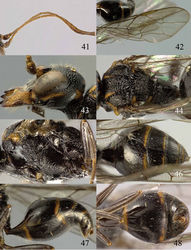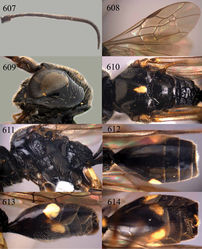Teranishia
| Notice: | This page is derived from the original publication listed below, whose author(s) should always be credited. Further contributors may edit and improve the content of this page and, consequently, need to be credited as well (see page history). Any assessment of factual correctness requires a careful review of the original article as well as of subsequent contributions.
If you are uncertain whether your planned contribution is correct or not, we suggest that you use the associated discussion page instead of editing the page directly. This page should be cited as follows (rationale):
Citation formats to copy and paste
BibTeX: @article{Chen2014ZooKeys385, RIS/ Endnote: TY - JOUR Wikipedia/ Citizendium: <ref name="Chen2014ZooKeys385">{{Citation See also the citation download page at the journal. |
Ordo: Hymenoptera
Familia: Trigonalyidae
Name
Teranishia Tsuneki, 1991 – Wikispecies link – Pensoft Profile
- Teranishia Tsuneki, 1991: 15; Lelej 1995[1]: 12; 2003[2]: 3; Carmean and Kimsey 1998[3]: 73. Type species (by original designation): Teranishia nipponica Tsuneki, 1991.
Diagnosis
Length of body 6.0–12.0 mm; antenna black and with 24–27 segments; area above supra-antennal elevations flat, more or less punctate, with protuberance between elevations and inner side of supra-antennal elevations flat, smooth and black (Figs 595, 606); tyloids on 11th–14th antennal segments of male absent; occipital carina widened medio-dorsally; apical segment of labial palp widened and obtuse, more or less triangular; vertex normal, at most with slight median depression dorsally (Fig. 595); mandibles wide in anterior view and sublaterally attached to head (Fig. 594); anterior propodeal sulcus distinctly crenulate (Fig. 599); metanotum strongly convex and finely sculptured medially (Fig. 599); anterior propodeal sulcus crenulate and medially widened (Figs 599, 610); posterior propodeal carina curved and distinctly protruding and more or less separated from foramen medio-dorsally (Figs 599, 610); fore wing with large dark patch below pterostigma; vein 1-SR of fore wing long (Figs 597, 608); hind trochanter black, dark brown or ivory; hind tarsus slightly or not modified; second and third sternites of + flat and moderately sclerotized and no protuberances (Fig. 603); body without pale pattern, at most malar space and margins of basal metasomal sternites and tergites narrowly ivory, remainder black.
Notes
According to Lelej (2003)[2] the female paratypes (not male holotype) of Teranishia nipponica belong to Teranishia marujamae Tsuneki, 1991. However, in the original description of Teranishia nipponica is indicated that the supra-antennal elevations have a medial yellow spot, which is absent in the holotype of Teranishia marujamae; therefore, we refrain from accepting this synonymy.
Key to species of Teranishia Tsuneki, 1991
Taxon Treatment
- Chen, H; van Achterberg, C; He, J; Xu, Z; 2014: A revision of the Chinese Trigonalyidae (Hymenoptera, Trigonalyoidea) ZooKeys, 385: 1-207. doi
Other References
- ↑ Lelej A (1995) [Fam. Trigonalidae - Trigonalid wasps]. In: Kupianskaya A Lelej A Storozheva N (Eds) [Key to the insects of Russian Far East] IV(2): 8–14. [in Russian]
- ↑ 2.0 2.1 Lelej A (2003) A review of the family Trigonalyidae (Hymenoptera) of the Palaearctic Region. Far Eastern Entomologist N 130: 1-7.
- ↑ Carmean D, Kimsey L (1998) Phylogenetic revision of the parasitoid wasp family Trigonalidae (Hymenoptera). Systematic Entomology 23: 35–76. doi: 10.1046/j.1365-3113.1998.00042.x
- ↑ Tsuneki K (1991) Revision of the Trigonalidae of Japan and adjacent territories (Hymenoptera). Special Publications Japan Hymenopterists Association 37: 1-68.
Images
|





